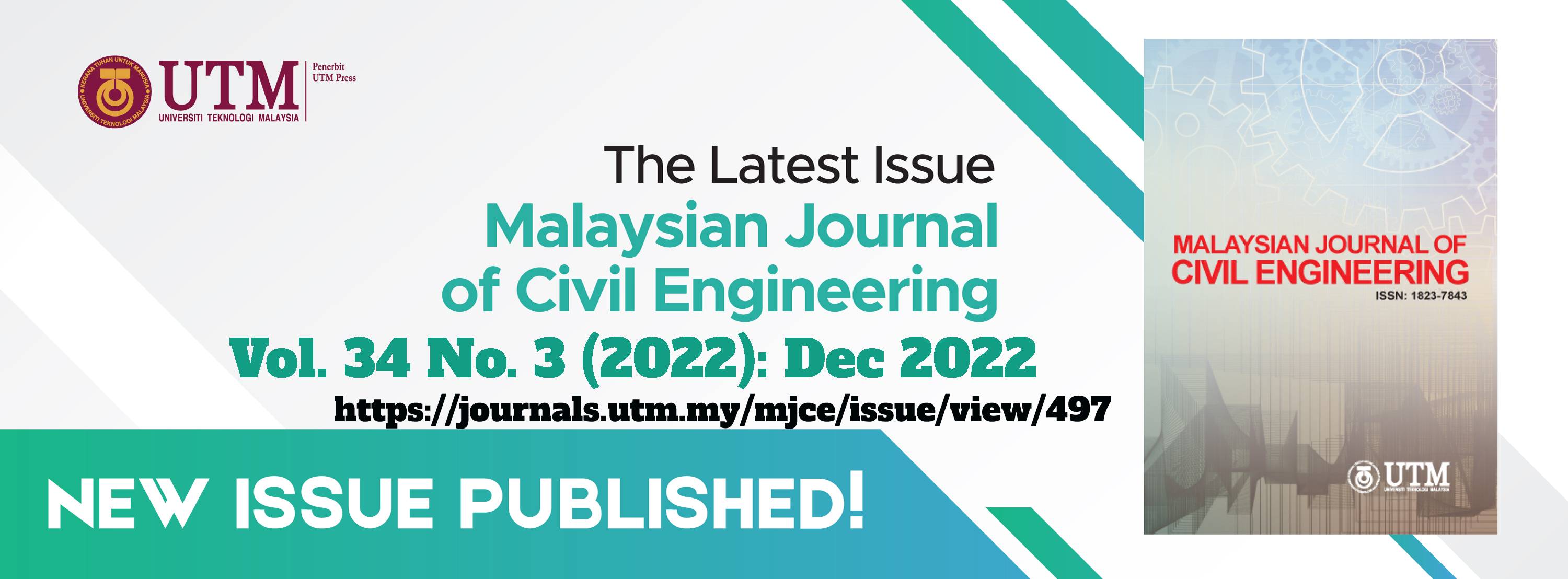EFFECTS OF EXPANDED POLYSTYRENE BEADS ON THE STRENGTH PROPERTIES OF BRICK AGGREGATE CONCRETE
DOI:
https://doi.org/10.11113/mjce.v34.18817Keywords:
Aggregate, EPS beads, Compressive strength, Splitting tensile strength, Unit weight, ExperimentAbstract
Bangladesh's construction industry has grown significantly over the past two decades. The construction industry is progressing at a faster speed, which has raised the raw demand for building materials. Finding an alternative to natural aggregate in concrete casting as a partial replacement is a smart concept to protect natural resources. Our environment is severely harmed by the production of bricks. On the other hand, polystyrene, a common plastic packaging material, degrades to harm the environment and produces useless plastic waste. To conserve natural resources, it can be a good idea to use plastic trash as a partial replacement for natural aggregate in concrete casting. The addition of EPS to concrete offers a variety of benefits. These include reduced self-weight in structures, lighter weights during construction, and higher thermal resistance. In this experiment on the characteristics of concrete structure, expanded polystyrene beads have been used in place of coarse aggregate in this experiment. In various combinations (1:1:2), (1:1.5:3), and (1:2:4), EPS beads replace 0%, 10%, 20%, and 30% of the volume of the course aggregate portion. The compressive strength, unit weight and splitting tensile strength of these mixes are all measured for the complete testing procedure. The optimal levels of compressive strength, splitting tensile strength, and unit weight of 12.65 MPa, 1.89 MPa, and 46.28 kg/m3 respectively, and the normal concrete's compressive strength, splitting tensile strength, and unit weight of about 19.16 MPa, 2.05 MPa, and 12.24 kg/m3 are successfully developed in Grade M25 EPS-based concrete with a replacement percentage of 10%. The results indicate that EPS beads have the potential to produce lightweight concrete with a moderate strength grade that might be used in a wide range of applications.
References
ACI Committee 304 1996 ACI 304.2R-96 - Placing concrete by pumping methods, American Concrete Institute, 304: 2R-96.
Askeland, D. R. 1996 Introduction to materials, The science and engineering of materials, Springer, Boston, MA. 2- 17.
ASTM C109 / C109M-16a (2016) Standard Test Method for Compressive Strength of Hydraulic Cement Mortars (Using 2-in. or [50-mm] Cube Specimens), ASTM International, West Conshohocken, PA.
ASTM C127-12 2012 Standard Test Method for Density, Relative Density (specific gravity) and Absorption of Coarse Aggregate.
ASTM C136 2016. Standard Test Method for Sieve Analysis of Fine and Coarse Aggregates, ASTM International, West Conshohocken, PA, USA.
ASTM C143 2005. Standard Test Method for Slump of Hydraulic-Cement SCC, ASTM International.
ASTM C150/C150M-17 2017. Standard Specification for Portland Cement, ASTM International, West Conshohocken, PA.
ASTM C187-16 2017. Standard Test Method for Amount of Water Required for Normal Consistency of Hydraulic Cement Paste, ASTM International, West Conshohocken, PA.
ASTM C29/C29M-09 2009. Standard Test Method for Bulk Density (unit weight) and Voids in Aggregate.
ASTM C642 2013. Standard Test Method for Density, Absorption and Voids in Hardened Concretes, ASTM International.
Cook, D. J. 1983 Expanded Polystyrene Concrete, Concrete Technology & Design, (Editor: R.N. Swamy), New Concrete Materials, 1: 41-69. Surrey University Press, England,
IS 383: 1970 Specifications for coarse and fine aggregates from natural sources for concrete, Bureau of Indian Standards, New Delhi.
Kole, S. N. and Suryawanshi, S. R. 2017. Study of use of polystyrene as a partial replacement for fine aggregate in concrete, International Journal of Engineering Science and Computing, 7(4): 1 -3
Kosmatka, S. H., Kerkhoff, B. & Panarese, W.C. 2002 Design and Control of Concrete Mixtures, 14th Ed., Illinois: Portland Cement Association.
Latifee, Dr. E. R. 2007 An Introduction to Properties and Evaluation of Engineering Materials, 1st edition, 95-113.
Maiti, S. C., Agarwal, R. K., and Kumar, R. 2006 Concrete mix proportioning, Indian Concrete Journal. 23–26.
Patel, Mr. R. 2020 Batching of concrete, Gharpedia, Website: https://gharpedia.com/blog/batching-of-concrete, (Accessed on November, 2021).
















